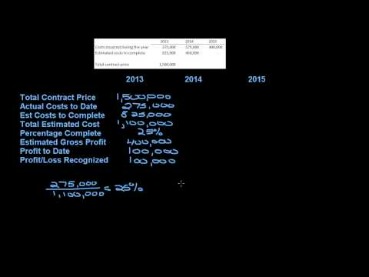
In some companies, there is little to no difference between sales and marketing, but under a revenue operations guided system, these departments need to be clearly marked and separate. The same applies to every other department at your business; everyone needs to know their specific task. Previously, revenue operations and sales operations were used interchangeably. But today, RevOps has evolved to become its own core function and a critical part of the revenue growth of all businesses. RevOps ties directly to an organization’s data, which continues to grow in importance.
HP Inc. Reports Fiscal 2023 Third Quarter Results – HP Press Center
HP Inc. Reports Fiscal 2023 Third Quarter Results.
Posted: Tue, 29 Aug 2023 20:32:56 GMT [source]
When you are discussing your financial statements with your accountant or bookkeeper, make sure you are clear about the terms they’re using so you’re on the same page about your business’s performance. A service-based business, like a preschool, sells services to its customers and the customers pay for those services through tuition. Like the nonprofit organization, the preschool might also sell merchandise, either to raise awareness or promote community spirit. Once a year, the preschool might also do a fundraising campaign to encourage past customers and other members of the community to contribute to the preschool’s capital fund.
What technology can support a revenue operations strategy?
Revenue Operations takes control of this tech stack, aligning it between marketing, sales, and customer success operations. While doing this, they collaborate with IT in order to keep privacy and security needs up to standard. In silos, each department has its own metrics, creating misalignment and different definitions of the same measurements.
- This makes it incredibly difficult to calculate an operating revenue figure given the vast array of services—ranging from very high-value workloads to smaller jobs that may be spread over a longer period of time.
- Managers are trying to use organizational systems developed in the 20th century to manage a far more advanced and digital commercial model in the 21st Century.
- At Salesforce, we set out to automate 90% of the order-to-cash process.
- Conduct market research and invest in the best technology for your company.
There are a few things to remember when analysing this metric, such as the type of business, the industry, and the company’s accounting practices. However, overall, it is a beneficial metric in assessing a company’s financial health. Since the operating income of a company is capital structure neutral and not impacted by non-operating costs – e.g. interest expense and taxes – the operating profit metric is widely used in corporate valuation. The operating income of a company is determined by subtracting its direct and indirect operating costs – i.e. cost of goods sold (COGS) and operating expenses (SG&A, R&D) – from its revenue. In general usage, revenue is the total amount of income by the sale of goods or services related to the company’s operations. Sales revenue is income received from selling goods or services over a period of time.
The difference between operating revenue vs. operating income
Revenue is often called the top line because it’s located at the top of an income statement. When a company is said to have “top-line growth,” it means the company’s revenue—the money it’s taking in—is growing. Revenue is the total amount of income that a company generates from the sale of goods and services.
Inform your colleagues of the positive benefits/outcomes of your planned changes. Without good data, tasks such as tracking KPIs, goal setting and forecasting become extremely challenging. To this end, establish cross-functional communication between your teams. By implementing a flexible and agile RevOps strategy, you can quickly adapt to changing market conditions and customer needs. When those elements cascade into every nook and cranny of the business, everyone can work together towards what success looks like.
In closing, Apple’s operating income in fiscal year 2022 is approximately $119.4 billion, which can be divided by its revenue to arrive at an operating margin of 30.3%. Your company will experience faster cycle times, reduced costs, and decreased error rates. Works on the collaboration between departments and the process of working. At the end of the day, it’s about aligning the processes, platforms, and people. Track down every kind of data (or “data element”) that has to do with revenue.
For example, you could distribute responsibilities related to revenue operations to your existing operations managers. Meanwhile, larger companies can dedicate someone exclusively to revenue operations under a single department. Here are some signs that you should integrate a revenue operations framework into your business. And hey, data from Gallup notes that strengths-based teams are more productive, profitable, and are more likely to stick with your company for the long-term.
The speed that leads move through each stage of your revenue pipeline. Eliminate repetitive sales tasks with personalized and segmented data. Get the complete customer picture that you need for more accurate and trustworthy reporting. Identify, target, and convert leads faster by getting them to the right person at the right time.
Nonoperating Revenue
Our clients engage us for our expertise on pricing, growth and demand sensitivity. They seek our advice on where their industry is heading to determine the right pricing strategy, how to price appropriately and how best to work with customers. Organizations historically have looked at competitive pricing to set their own pricing strategy. But as markets mature and change, their legacy pricing tactics may no longer work. We help you deploy the next level of market-leading pricing tactics, ensuring that competitors are not undercutting you. It’s never enough to just automate individual tasks, or even empower individual employees with some new powerful software.

The average team is understandably bogged down by too many software solutions and likewise spending time trying to learn them all. We’ve talked before about how lists such as the massive Martech 5000 are evidence of just how many choices companies have in regard to their marketing stacks. These metrics signal the level of expertise required for someone to succeed at RevOps. Those in RevOps have a pulse on market trends including competing products and the state of the economy. Introducing Slack, Asana or other productivity/task management platforms fosters greater collaboration and knowledge-sharing. Automating lead routing and qualification ensures your SDRs are focused on the most promising leads.
People
Since operating revenue focuses on inflows from your key operating activities, it’s a crucial metric to track. Operating revenue and non-operating revenue are often wrongly referred to as something similar. Non-operating revenue refers to earnings that are generated from sources other than core operations. Operating revenue is revenue earned from a business’s main activities, whether selling goods or services. For example, a bakery’s operating revenue comes from selling baked goods.
This revenue is not expected as a normal course of doing business, and the one-time revenue should not be used to assess the success of the company’s primary operations year over year. Operating revenue is income generated by an entity from its daily core business operations. Example – ABC Automobile Co. makes and sells automobiles as their daily core business, so their revenue from operations is said to be generated by the selling of automobiles only. These include the cost of raw materials, the cost of labour, the cost of other expenses such as rent and utilities, and the price of the final product. In addition, companies may also be limited by the amount of capacity that they have available to produce goods or services.
Additional benefits are shorter sales cycles, improved retention and a higher upsell volume. As much as 40% of our time at work can be reduced with automation and behavior change, according to PwC. When we automate our way out of manual tasks, we have free time to focus on the big picture, and study revenue data for insights 17 advantages and disadvantages of zero based budgeting that help us grow the business. Some departments might report to the new RevOps team, and others will stay where they are — for example, in legal — but with an added commitment to support revenue success. But as the graphic below shows, sales ops is just a piece of the puzzle, because revenue data starts at the product.
Likewise, more accurate revenue forecasting after deciding which tools, processes, and strategies result in growth. Rather than keep divisions and departments siloed off, teams should be encouraged to work in tandem to drive revenue growth. Learn about Revenue Operations (RevOps) as a strategy to align siloed revenue teams within B2B and B2C companies and unify revenue goals and targets.
Meet Superframe, the AI startup that wants to be your copilot for … – VentureBeat
Meet Superframe, the AI startup that wants to be your copilot for ….
Posted: Thu, 31 Aug 2023 15:59:00 GMT [source]
The corporation, conglomerate, and business unit structures pioneered by Rockefeller (standard oil), Reginald Jones (GE), and Alfred Sloan (GM) respectively were all structural innovations that served their purpose in their time. But modern selling requires levels of speed, accountability, visibility, and teamwork that are unmanageable in a traditional functional stovepipe organization model. This makes it incredibly difficult to calculate an operating revenue figure given the vast array of services—ranging from very high-value workloads to smaller jobs that may be spread over a longer period of time. For CPG (consumer package goods) companies, operating revenue represents new product sales plus add-on sales (like accessories or higher-margin products). Conversely, net income is revenue minus all expenses, including operating expenses and nonoperating expenses, such as taxes.
What does successful revenue operations look like?
This will include data that begins all the way upstream, when you create products, and ends all the way downstream, when you recognize revenue in your ERP. Data doesn’t flow automatically between these systems, so your teams have to spend time every day taking data from over here, and reentering it over there. To define revenue strategy, execute GTM activities, construct and optimize revenue systems, pipeline management, ROI on spend, churn. The good news is that there is no “right” revenue ops team structure, especially if you’re relatively small. As long as you acknowledge the challenges above and the need to take a more comprehensive and collaborative approach to grow revenue, you’re on the right path. For example, according to a Harvard Business Review piece, sales teams struggle with forecasting and perhaps that responsibility shouldn’t necessarily be on their shoulders.
